Does Wolf Management in Latvia Decrease Livestock Depredation? An Analysis of Available Data
Abstract
1. Introduction
2. Materials and Methods
2.1. Wolves in Latvia
2.2. Data Acquisition and Preparation
2.3. Data Analysis
3. Results
4. Discussion
5. Conclusions
Author Contributions
Funding
Institutional Review Board Statement
Informed Consent Statement
Data Availability Statement
Acknowledgments
Conflicts of Interest
Appendix A. Summary of Analyzed Data
| Dienvidkurzeme | Ziemeļkurzeme | Zemgale | Rīga Regional | |
| Reported wolf attacks on sheep | 1–9 (3) | 1–8 (3) | 5 | 1–4 (1) |
| Total number of affected sheep | 1–61 (20) | 1–50 (17.5) | 26 | 1–24 (12.5) |
| Estimated number of wolves | 95–337 (169) | 77–260 (158) | 11–129 (88) | 5–45 (14) |
| Number of culled wolves | 20–42 (28) | 17–55 (39) | 3–39 (14) | 1–11 (5) |
| Age structure | 175 juv 30 subad 130 ad | 163 juv 36 subad 171 ad | 85 juv 11 subad 58 ad | 26 juv 4 subad 21 ad |
| Estimated numbers of other wildlife (thousands) | red deer 4.9–14.3 (10.8) roe deer 13.4–38 (22.4) wild boars 2.4–12.7 (7.2) beavers 4.9–13 (7.7) | red deer 6.6–13.6 (10.6) roe deer 7.3–22.6 (9) wild boars 1.2–11.4 (6.1) beavers 3.0–8.4 (4.0) | red deer 1.9–13.9 (10.2) roe deer 13.6–27.4 (22.9) wild boars 2.3–11.1 (4.0) beavers 3.4–12.3 (7.0) | red deer 1.3–4.3 (2.0) roe deer 8.9–28.9 (17.4) wild boars 0.8–5.8 (2.3) beavers 4.1–10.6 (5.7) |
| Sēlija | Dienvidlatgale | Austrumlatgale | ||
| Reported wolf attacks on sheep | 1–6 (1) | 1–12 (2) | 1–11 (3.5) | |
| Total number of affected sheep | 1–31 (11) | 7–68 (12) | 2–58 (16) | |
| Estimated number of wolves | 63–190 (151) | 39–189 (124) | 68–180 (99) | |
| Number of culled wolves | 5–37 (22) | 4–36 (15) | 6–53 (20) | |
| Age structure | 101 juv 24 subad 82 ad | 50 juv 10 subad 45 ad | 57 juv 6 subad 56 ad | |
| Estimated numbers of other wildlife (thousands) | red deer 2.2–7.7 (5.2) roe deer 11.1–28.3 (18.4) wild boars 1.6–7.5 (3.7) beavers 2–7.7 (6.6) | red deer 0.5–3.1 (1.4) roe deer 10.1–25.4 (16.5) wild boars 1.9–5.9 (3.0) beavers 7.9–13.0 (11.6) | red deer 0.2–1.8 (0.7) roe deer 9.2–15.1 (12.2) wild boars 1.3–4.3 (2.7) beavers 6.2–8.6 (7.3) | |
| Centrālvidzeme | Ziemeļvidzeme | Ziemeļaustrumi | ||
| Reported wolf attacks on sheep | 1–28 (2) | 1–9 (3.5) | 1–9 (1) | |
| Total number of affected sheep | 1–277 (14) | 3–76 (27) | 2–62 (5) | |
| Estimated number of wolves | 11–205 (61) | 41–143 (79) | 33–169 (70) | |
| Number of culled wolves | 4–47 (19) | 2–42 (28) | 3–45 (19) | |
| Age structure | 71 juv 15 subad 68 ad | 139 juv 17 subad 73 ad | 103 juv 10 subad 65 ad | |
| Estimated numbers of other wildlife (thousands) | red deer 1–7.2 (4.5) roe deer 8.9–21.5 (13.5) wild boars 2.4–7.3 (4.2) beavers 5.0–8.9 (6.4) | red deer 1.5–4.7 (3.7) roe deer 12.6–41.2 (20.1) wild boars 1.1–10 (4.4) beavers 5.4–11.9 (6.5) | red deer 0.7–5.1 (2.7) roe deer 6.1–23.3 (10.0) wild boars 1.0–6.3 (2.6) beavers 4.1–8.4 (4.9) | |
| Kurzeme | Zemgale | Pierīga | Vidzeme | Latgale | |
|---|---|---|---|---|---|
| Non-urban area (km2) | 12,995 | 10,678 | 8562 | 15,750 | 14,463 |
| Number of sheep (thousands) | 4.4–19.0 (12.9) | 2.0–14.6 (10.7) | 3.8–17.8 (11.8) | 7.0–33.5 (23.1) | 20.0–28.5 (26.3) |
| Constant or Variable | Coefficient |
|---|---|
| Cumulative number of wolf attacks on sheep per year | 1 |
| Cumulative number of affected sheep in wolf attacks per year | 1 |
| Intercept | βint |
| Centrālvidzeme SFS forestry unit | βforestry[CV] |
| Dienvidkurzeme SFS forestry unit | βforestry[DK] |
| Dienvidlatgale SFS forestry unit | βforestry[DL] |
| Rīga Regional SFS forestry unit | βforestry[RR] |
| Sēlija SFS forestry unit | βforestry[S] |
| Ziemeļaustrumi SFS forestry unit | βforestry[ZA] |
| Ziemeļkurzeme SFS forestry unit | βforestry[ZK] |
| Ziemeļvidzeme SFS forestry unit | βforestry[ZV] |
| Mean number of sheep per 1 km2 in respective region | βsheep |
| Estimated number of red deer in current year in current year (in thousands) | βwild[redd] |
| Estimated number of roe deer in current year in current year (in thousands) | βwild[roed] |
| Estimated number of wild boars in current year in current year (in thousands) | βwild[wildb] |
| Estimated number of beavers in current year in current year (in thousands) | βwild[beav] |
| Estimated number of red deer in previous year in previous year (in thousands) | βprevwild[redd] |
| Estimated number of roe deer in previous year in previous year (in thousands) | βprevwild[roed] |
| Estimated number of wild boars in previous year in previous year (in thousands) | βprevwild[wildb] |
| Estimated number of beavers in previous year in previous year (in thousands) | βprevwild[beav] |
| Estimated number of wolves in current year | βwolf |
| Logit-transformed proportion of culled wolves in current year | βwcull |
| Logit-transformed proportion of culled wolves in previous year | βprevwcull |
| Logit-transformed proportion of juvenile wolves in current year | βwjuv |
| Coefficients (±SE) | θ (±SE) | AICc | ∆ | ω | ER |
|---|---|---|---|---|---|
| βint = 0.742 (±0.366) * | 5.96 (±3.07) | 243.65 | 0 | 0.562 | 1 |
| βsheep = 0.442 (±0.195) * | |||||
| βwcull = 0.263 (±0.124) * | |||||
| βint = 0.293 (±0.316) | 5.13 (±2.44) | 245.39 | 1.73 | 0.236 | 2.4 |
| βsheep = 0.55 (±0.196) ** | |||||
| βint = 1.501 (±0.163) *** | 4.71 (±2.09) | 246.37 | 2.71 | 0.145 | 3.9 |
| βwcull = 0.345 (±0.125) ** | |||||
| βint = 0.999 (±0.374)** | 12.6 (±11.0) | 250.02 | 6.37 | 0.023 | 24.1 |
| βforestry[CV] = −0.304 (±0.376) | |||||
| βforestry[DK] = −1.086 (±0.368) ** | |||||
| βforestry[DL] = −1.279 (±0.391) ** | |||||
| βforestry[RR] = −1.234 (±0.669) | |||||
| βforestry[S] = −0.858 (±0.335) * | |||||
| βforestry[ZA] = −0.824 (±0.351) * | |||||
| βforestry[ZK] = −1.173 (±0.377) ** | |||||
| βforestry[ZV] = −0.099 (±0.28) | |||||
| βwolf = 0.007 (±0.003) * | |||||
| βint = 1.127 (±0.101) *** | 3.81 (±1.52) | 250.96 | 7.31 | 0.015 | 38.6 |
| βint = 0.826 (±0.496) | 14.5 (±14.3) | 252.52 | 8.87 | 0.012 | 46.4 |
| βforestry[CV] = −0.545 (±0.367) | |||||
| βforestry[DK] = −0.128 (±0.393) | |||||
| βforestry[DL] = −0.867 (±0.39) * | |||||
| βforestry[RR] = −1.436 (±0.638) * | |||||
| βforestry[S] = −0.489 (±0.342) | |||||
| βforestry[ZA] = −0.84 (±0.34) * | |||||
| βforestry[ZK] = −0.359 (±0.352) | |||||
| βforestry[ZV] = −0.14 (±0.276) | |||||
| βsheep = 0.539 (±0.225) * | |||||
| βwcull = 0.113 (±0.135) | |||||
| βint = 1.735 (±0.221) *** | 8.58 (±5.69) | 252.47 | 8.82 | 0.007 | 82.1 |
| βforestry[CV] = −0.482 (±0.387) | |||||
| βforestry[DK] = −0.736 (±0.344) * | |||||
| βforestry[DL] = −1.042 (±0.389) ** | |||||
| βforestry[RR] = −1.735 (±0.649) ** | |||||
| βforestry[S] = −0.79 (±0.348) * | |||||
| βforestry[ZA] = −1.042 (±0.355) ** | |||||
| βforestry[ZK] = −0.736 (±0.344) * | |||||
| βforestry[ZV] = −0.253 (±0.289) |
| Coefficients (±SE) | θ (±SE) | AICc | ∆ | ω | ER |
|---|---|---|---|---|---|
| βint = 1.486 (±0.41) *** | 1.505 (±0.287) | 474.97 | 0 | 0.423 | 1 |
| βsheep = 0.833 (±0.226) *** | |||||
| βwild[redd] = 0.075 (±0.031) * | |||||
| βint = 1.564 (±0.42) *** | 1.462 (±0.277) | 476.68 | 1.71 | 0.18 | 2.4 |
| βsheep = 0.674 (±0.221) ** | |||||
| βwolf = 0.005 (±0.002) * | |||||
| βint = 1.414 (±0.427) *** | 1.512 (±0.289) | 476.98 | 2.01 | 0.155 | 2.7 |
| βsheep = 0.798 (±0.233) *** | |||||
| βwild[redd] = 0.06 (±0.041) | |||||
| βwolf = 0.002 (±0.003) | |||||
| βint = 2.128 (±0.349) *** | 1.379 (±0.259) | 478.07 | 3.09 | 0.09 | 4.7 |
| βsheep = 0.65 (±0.226) ** | |||||
| βint = 2.982 (±0.311) *** | 1.922 (±0.386) | 478.94 | 3.97 | 0.058 | 7.3 |
| βforestry[CV] = −1.048 (±0.586) | |||||
| βforestry[DK] = −3.085 (±0.778) *** | |||||
| βforestry[DL] = −0.521 (±0.438) | |||||
| βforestry[RR] = −1.419 (±0.56) * | |||||
| βforestry[S] = −1.366 (±0.504) ** | |||||
| βforestry[ZA] = −1.585 (±0.438) *** | |||||
| βforestry[ZK] = −3.389 (±0.934) *** | |||||
| βforestry[ZV] = −0.547 (±0.442) | |||||
| βwild[redd] = 0.311 (±0.078) *** | |||||
| βint = 2.291 (±0.463) *** | 2.026 (±0.411) | 479.05 | 4.07 | 0.055 | 7.7 |
| βforestry[CV] = −0.449 (±0.634) | |||||
| βforestry[DK] = −2.657 (±0.78) *** | |||||
| βforestry[DL] = −0.632 (±0.439) | |||||
| βforestry[RR] = −0.826 (±0.629) | |||||
| βforestry[S] = −0.99 (±0.507) | |||||
| βforestry[ZA] = −1.21 (±0.465) ** | |||||
| βforestry[ZK] = −2.86 (±0.938) ** | |||||
| βforestry[ZV] = −0.111 (±0.473) | |||||
| βwild[redd] = 0.225 (±0.087) ** | |||||
| βwolf = 0.007 (±0.004) | |||||
| βint = 1.988 (±0.465) *** | 1.85 (±0.37) | 481.36 | 6.39 | 0.017 | 24.4 |
| βforestry[CV] = 0.712 (±0.497) | |||||
| βforestry[DK] = −0.894 (±0.461) | |||||
| βforestry[DL] = −0.602 (±0.458) | |||||
| βforestry[RR] = −0.264 (±0.611) | |||||
| βforestry[S] = −0.246 (±0.428) | |||||
| βforestry[ZA] = −0.606 (±0.435) | |||||
| βforestry[ZK] = −0.697 (±0.475) | |||||
| βforestry[ZV] = 0.658 (±0.4) | |||||
| βwolf = 0.011 (±0.003) *** | |||||
| βint = 2.404 (±0.618) *** | 2.025 (±0.411) | 482.19 | 7.22 | 0.011 | 36.9 |
| βforestry[CV] = −0.489 (±0.646) | |||||
| βforestry[DK] = −2.851 (±1.08) ** | |||||
| βforestry[DL] = −0.654 (±0.455) | |||||
| βforestry[RR] = −0.875 (±0.636) | |||||
| βforestry[S] = −1.082 (±0.599) | |||||
| βforestry[ZA] = −1.254 (±0.486) ** | |||||
| βforestry[ZK] = −3.046 (±1.198) * | |||||
| βforestry[ZV] = −0.15 (±0.508) | |||||
| βsheep = −0.08 (±0.321) | |||||
| βwild[redd] = 0.237 (±0.096) * | |||||
| βwolf = 0.007 (±0.004) | |||||
| βint = 3.114 (±0.121) *** | 1.241 (±0.228) | 482.53 | 7.56 | 0.01 | 43.8 |
References
- Fritts, S.H.; Stephenson, R.O.; Hayes, R.D.; Boitani, L. Wolves and Humans. In Wolves: Behavior, Ecology and Conservation; Mech, L.D., Boitani, L., Eds.; The University of Chicago Press: Chicago, IL, USA, 2003; pp. 289–316. [Google Scholar]
- Kaczensky, P. Large carnivore depredation on livestock in Europe. Ursus 1999, 11, 59–71. [Google Scholar]
- Boitani, L. Action Plan for the Conservation of Wolves in Europe (Canis lupus); Council of Europe Publishing: Strasbourg, France, 2000. [Google Scholar]
- Mishra, C. Livestock depredation by large carnivores in the Indian trans-Himalaya: Conflict perceptions and conservation prospects. Environ. Conserv. 1997, 24, 338–343. [Google Scholar] [CrossRef]
- Wilson, C.J. Could we live with reintroduced large carnivores in the UK? Mammal Rev. 2004, 34, 211–232. [Google Scholar] [CrossRef]
- Ginsberg, J.R. Setting priorities for carnivore conservation: What makes carnivores different. In Carnivore Conservation; Conservation Biology Series; Gittleman, J.L., Funk, S.M., Macdonald, D.W., Wayne, R.K., Eds.; Cambridge University Press: Cambridge, UK, 2001; pp. 498–523. [Google Scholar]
- Chapron, G.; Kaczensky, P.; Linnell, J.D.C.; von Arx, M.; Huber, D.; Andrén, H.; López-Bao, J.V.; Adamec, M.; Álvares, F.; Anders, O.; et al. Recovery of large carnivores in Europe’s modern human-dominated landscapes. Science 2014, 346, 1517–1519. [Google Scholar] [CrossRef] [PubMed]
- Meuret, M.; Moulin, C.-H.; Bonnet, O.; Garde, L.; Nozières-Petit, M.-O.; Lescureux, N. Missing shots: Has the possibility of shooting wolves been lacking for 20 years in France’s livestock protection measures? Rangel. J. 2020, 42, 401–413. [Google Scholar] [CrossRef]
- Fritts, S.H.; Paul, J.W.; Mech, L.D.; Scott, D.P. Trends and Management of Wolf–Livestock Conflicts in Minnesota; Resource Publication 181; United States Department of the Interior Fish and Wildlife Service: Washington, DC, USA, 1992. [Google Scholar]
- Wydeven, A.P.; Treves, A.; Brost, B.; Wiedenhoeft, J. Characteristics of wolf packs in Wisconsin: Identification of traits influencing depredation. In People and Predators: From Conflict to Coexistence; Fascione, N., Delach, A., Smith, M.E., Eds.; Island Press: Washington, DC, USA, 2004; pp. 28–50. [Google Scholar]
- Treves, A.; Martin, K.A.; Wydeven, A.P.; Wiedenhoeft, J. Forecasting Environmental Hazards and the Application of Risk Maps to Predator Attacks on Livestock. BioScience 2011, 61, 451–458. [Google Scholar] [CrossRef]
- Štrbenac, A. Wolf Management Plan for Croatia: Towards Understanding and Addressing Key Issues in Wolf Management Planning in Croatia; State Institute for Nature Protection: Zagreb, Croatia, 2005. [Google Scholar]
- Gula, R. Wolf Depredation on Domestic Animals in the Polish Carpathian Mountains. J. Wildl. Manag. 2008, 72, 283–289. [Google Scholar] [CrossRef]
- Krofel, M.; Cerne, R.; Jerina, K. Effectiveness of wolf (Canis lupus) culling as a measure to reduce livestock depredations. Zb. Gozdarstva Lesar. 2011, 95, 11–22. [Google Scholar]
- Widman, M.; Elofsson, K. Costs of Livestock Depredation by Large Carnivores in Sweden 2001 to 2013. Ecol. Econ. 2018, 143, 188–198. [Google Scholar] [CrossRef]
- Remm, J.; Hindrikson, M. Estonian Conservation and Management Plan of Large Carnivores 2022–2031; Environmental Board: Pärnu, Estonia, 2022. [Google Scholar]
- Ozoliņš, J.; Žunna, A.; Ornicāns, A.; Done, G.; Stepanova, A.; Pilāte, D.; Šuba, J.; Lūkins, M.; Howlett, S.J.; Bagrade, G. Action Plan for Grey Wolf Canis lupus Conservation and Management; LSFRI Silava: Salaspils, Latvia, 2017. [Google Scholar]
- Game Resources. Available online: https://www.vmd.gov.lv/lv/es-sfera-esoso-sugu-monitorings (accessed on 12 December 2022).
- Frank, L.G.; Woodroffe, R. Behaviour of carnivores in exploited and controlled populations. In Carnivore Conservation; Conservation Biology Series; Gittleman, J.L., Funk, S.M., Macdonald, D.W., Wayne, R.K., Eds.; Cambridge University Press: Cambridge, UK, 2001; pp. 419–442. [Google Scholar]
- Treves, A.; Krofel, M.; McManus, J. Predator control should not be a shot in the dark. Front. Ecol. Environ. 2016, 14, 380–388. [Google Scholar] [CrossRef]
- Berger, K.M. Carnivore-Livestock Conflicts: Effects of Subsidized Predator Control and Economic Correlates on the Sheep Industry. Conserv. Biol. 2006, 20, 751–761. [Google Scholar] [CrossRef] [PubMed]
- Harper, E.K.; Paul, W.J.; Mech, L.D.; Weisberg, S. Effectiveness of Lethal, Directed Wolf-Depredation Control in Minnesota. J. Wildl. Manag. 2008, 72, 778–784. [Google Scholar] [CrossRef]
- Bruns, A.; Waltert, M.; Khorozyan, I. The effectiveness of livestock protection measures against wolves (Canis lupus) and implications for their co-existence with humans. Glob. Ecol. Conserv. 2020, 21, e00868. [Google Scholar] [CrossRef]
- Musiani, M.; Mamo, C.; Boitani, L.; Callaghan, C.; Gates, C.C.; Mattei, L.; Visalberghi, E.; Breck, S.; Volpi, G. Wolf depredation trends and the use of fladry barriers to protect livestock in western North America. Conserv. Biol. 2003, 17, 1538–1547. [Google Scholar] [CrossRef]
- Eklund, A.; López-Bao, J.; Tourani, M.; Chapron, G.; Frank, J. Limited evidence on the effectiveness of interventions to reduce livestock predation by large carnivores. Sci. Rep. 2017, 7, 2097. [Google Scholar] [CrossRef]
- Kaartinen, S.; Luoto, M.; Kojola, I. Carnivore-livestock conflicts: Determinants of wolf (Canis lupus) depredation on sheep farms in Finland. Biodivers Conserv. 2009, 18, 3503–3517. [Google Scholar] [CrossRef]
- Šuba, J.; Žunna, A.; Bagrade, G.; Done, G.; Lūkins, M.; Ornicāns, A.; Pilāte, D.; Stepanova, A.; Ozoliņš, J. Closer to Carrying Capacity: Analysis of the Internal Demographic Structure Associated with the Management and Density Dependence of a Controlled Wolf Population in Latvia. Sustainability 2021, 13, 9783. [Google Scholar] [CrossRef]
- Žunna, A.; Ozoliņš, J.; Pupila, A. Food habits of the wolf Canis lupus in Latvia based on stomach analyses. Est. J. Ecol. 2009, 58, 141–152. [Google Scholar] [CrossRef]
- Bagrade, G.; Ruņģis, D.I. Latvian State Forest Research Institute Silava, Salaspils, Latvia. 2023; unpublished work. [Google Scholar]
- Population of Game Species. Available online: https://www.vmd.gov.lv/lv/medijamo-dzivnieku-populacijas (accessed on 1 March 2023).
- Linnell, J.D.C.; Odden, J.; Mertens, A. Mitigation methods for conflicts associated with carnivore depredation on livestock. In Carnivore Ecology and Conservation: A Handbook of Techniques; Boitani, L., Powell, R.A., Eds.; Oxford University Press: New York, NY, USA, 2012; pp. 314–332. [Google Scholar]
- Reinhardt, I.; Rauer, G.; Kluth, G.; Kaczensky, P.; Knauer, F.; Wotschikowsky, U. Livestock protection methods applicable for Germany—A Country newly recolonized by wolves. Hystrix 2012, 23, 62–72. [Google Scholar] [CrossRef]
- Salvatori, V.; Mertens, A.D. Damage prevention methods in Europe: Experiences from LIFE nature projects. Hystrix 2012, 23, 73–79. [Google Scholar] [CrossRef]
- Klevezal, G.A. Age-Related Structures in Zoological Studies of Mammals; Nauka: Moscow, Russia, 1988. (In Russian) [Google Scholar]
- R Core Team. R: A Language and Environment for Statistical Computing. R Foundation for Statistical Computing, Vienna, Austria, 2017. Available online: https://www.R-project.org/ (accessed on 2 December 2021).
- Ciucci, P.; Boitani, L. Wolf and Dog Depredation on Livestock in Central Italy. Wildl. Soc. B 1998, 26, 504–514. [Google Scholar]
- Blanco, J.C.; Cortes, Y. Wolf recolonization of agricultural areas in Spain. In Proceedings of the Beyond 2000: Realities of Global Wolf Restoration, Duluth, MN, USA, 23–26 February 2000. [Google Scholar]
- Adamič, M.; Kobler, A.; Korenjak, A.; Marinčič, A.; Zafran, J. The recovery of the wolf (Canis lupus) in Slovenia. Beitr. Jagd Wildforschung 2001, 26, 85–94. [Google Scholar]
- Balčiauskas, L.; Balčiauskienė, L.; Volodka, H. Preliminary assessment of damage caused by the wolf in Lithuania. Acta Zool. Lit. 2002, 12, 419–427. [Google Scholar] [CrossRef]
- Kaczensky, P.; Chapron, G.; von Arx, M.; Huber, D.; Andrén, H.; Linnell, J. (Eds.) Status, Management and Distribution of Large Carnivores—Bear, Lynx, Wolf and Wolverine—In Europe; Part 2—Species Country Reports; IUCN/SSC Large Carnivore Initiative for Europe; The Institute of Applied Ecology, Istituto di Ecologia Applicata: Rome, Italy, 2013. [Google Scholar]
- Kaczensky, P. Large carnivore-livestock conflicts in Europe; Munich Wildlife Society: Munich, Germany, 1996. [Google Scholar]
- Fryxell, J.M.; Sinclair, A.R.E.; Caughley, G. Wildlife Ecology, Conservation, and Management; John Wiley & Sons: New York, NY, USA, 2014. [Google Scholar]
- Adams, L.G.; Stephenson, R.O.; Dale, B.W.; Ahgook, R.T.; Demma, D.J. Population dynamics and harvest characteristics of wolves in the Central Brooks Range, Alaska. Wildl. Monogr. 2008, 170, 1–25. [Google Scholar] [CrossRef]
- Brainerd, S.M.; Andren, H.; Bangs, E.E.; Bradley, E.H.; Fontaine, J.A.; Hall, W.; Iliopoulos, Y.; Jimenez, M.D.; Jozwiak, E.A.; Liberg, O.; et al. The effects of breeder loss on wolves. J. Wildl. Manag. 2008, 72, 89–98. [Google Scholar] [CrossRef]
- Mech, L.D. The Wolf: The Ecology and Behaviour of an Endangered Species; University of Minnesota Press: Minneapolis, MN, USA, 1970. [Google Scholar]
- Ozoliņš, J.; Stepanova, A.; Žunna, A.; Bagrade, G.; Ornicāns, A. Wolf hunting in Latvia in the light of population continuity in the Baltics. In Beiträge zur Jagd- und Wildforschung, Band 36; Stubbe, M., Ed.; Gesellschaft für Wildtier- und Jagdforschung e.V.: Halle/Saale, Deutschland, 2011; pp. S. 93–104. [Google Scholar]
- Ozoliņš, J.; Žunna, A.; Howlett, S.J.; Bagrade, G.; Pilāte, D.; Ornicāns, A.; Pēterhofs, E. Population dynamics of large mammals in Latvia with an emphasis on prey-predator interactions. In Beiträge zur Jagd- und Wildforschung. Band 41; Stubbe, M., Ed.; Gesellschaft für Wildtier- und Jagdforschung e.V.: Halle/Saale, Deutschland, 2016; pp. S. 59–73. [Google Scholar]
- Latham, J.; Staines, J.B.W.; Gorman, M.L. Correlations of red (Cervus elaphus) and roe (Capreolus capreolus) deer densities in Scottish forests with environmental variables. J. Zool. 1997, 242, 681–704. [Google Scholar] [CrossRef]
- Richard, E.; Gaillard, J.M.; Saïd, S.; Harmann, J.-L.; Klein, F. High red deer density depresses body mass of roe deer fawns. Oecologia 2010, 163, 91–97. [Google Scholar] [CrossRef] [PubMed]
- Jędrzejewska, B.; Jędrzejewski, W. Predation in Vertebrate Communities: The Białowieża Primeval Forest as a Case Study; Springer: Berlin/Heidelberg, Germany, 1998; Volume 135. [Google Scholar]
- Andersone, Ž.; Ozolinš, J. Public perception of large carnivores in Latvia. Ursus 2004, 15, 181–187. [Google Scholar] [CrossRef]
- Žunna, A.; Bagrade, G.; Ozoliņš, J. Attitudes of the General Public and Hunters Towards Wolves in Latvia; Its Predictors and Changes Over Time. Proc. Latv. Acad. Sci. B Nat. Exact Appl. Sci. 2020, 74, 280–286. [Google Scholar] [CrossRef]
- Bath, A.J. Attitudes of Various Interest Groups in Wyoming Toward Wolf Reintroduction in Yellowstone National Park. Master’s Thesis, University of Wyoming, Laramie, WY, USA, 1987. [Google Scholar]
- Kellert, S.R. The Public and the Timber Wolf in Minnesota. Anthrozoös 1987, 1, 100–109. [Google Scholar] [CrossRef]
- Bath, A.J.; Buchanan, T. Attitudes of interest groups in Wyoming towards wolf restoration in Yellowstone National Park. Wildl. Soc. B 1989, 17, 519–525. [Google Scholar]
- Blanco, J.C.; Reig, S.; Cuesta, L. Distribution, status and conservation problems of the wolf Canis lupus in Spain. Biol. Conserv. 1992, 60, 73–80. [Google Scholar] [CrossRef]
- Williams, C.K.; Ericsson, G.; Heberlein, T.A. A quantitative summary of attitudes toward wolves and their reintroduction (1972–2000). Wildl. Soc. B 2002, 30, 575–584. [Google Scholar] [CrossRef]
- Røskaft, E.; Händel, B.; Bjerke, T.; Kaltenborn, B.P. Human attitudes towards large carnivores in Norway. Wildl. Biol. 2007, 13, 172–185. [Google Scholar] [CrossRef]
- Sponarski, C.C.; Semeniuk, C.; Glikman, J.A.; Bath, A.J.; Musiani, M. Heterogeneity among Rural Resident Attitudes Toward Wolves. Hum. Dimens. Wildl. 2013, 18, 239–248. [Google Scholar] [CrossRef]
- Ericsson, G.; Heberlein, T.A. Attitudes of hunters, locals and general public in Sweden now that wolves are back. Biol. Conserv. 2003, 111, 149–159. [Google Scholar] [CrossRef]
- Heberlein, T.A. Navigating Environmental Attitudes; Oxford University Press: New York, NY, USA, 2012. [Google Scholar]
- Sillero-Zubiri, C.; Laurenson, K. Interactions between carnivores and local communities: Conflict or co-existence. In Carnivore conservation; Conservation Biology Series; Gittleman, J.L., Funk, S.M., Macdonald, D.W., Wayne, R.K., Eds.; Cambridge University Press: Cambridge, UK, 2001; pp. 282–312. [Google Scholar]
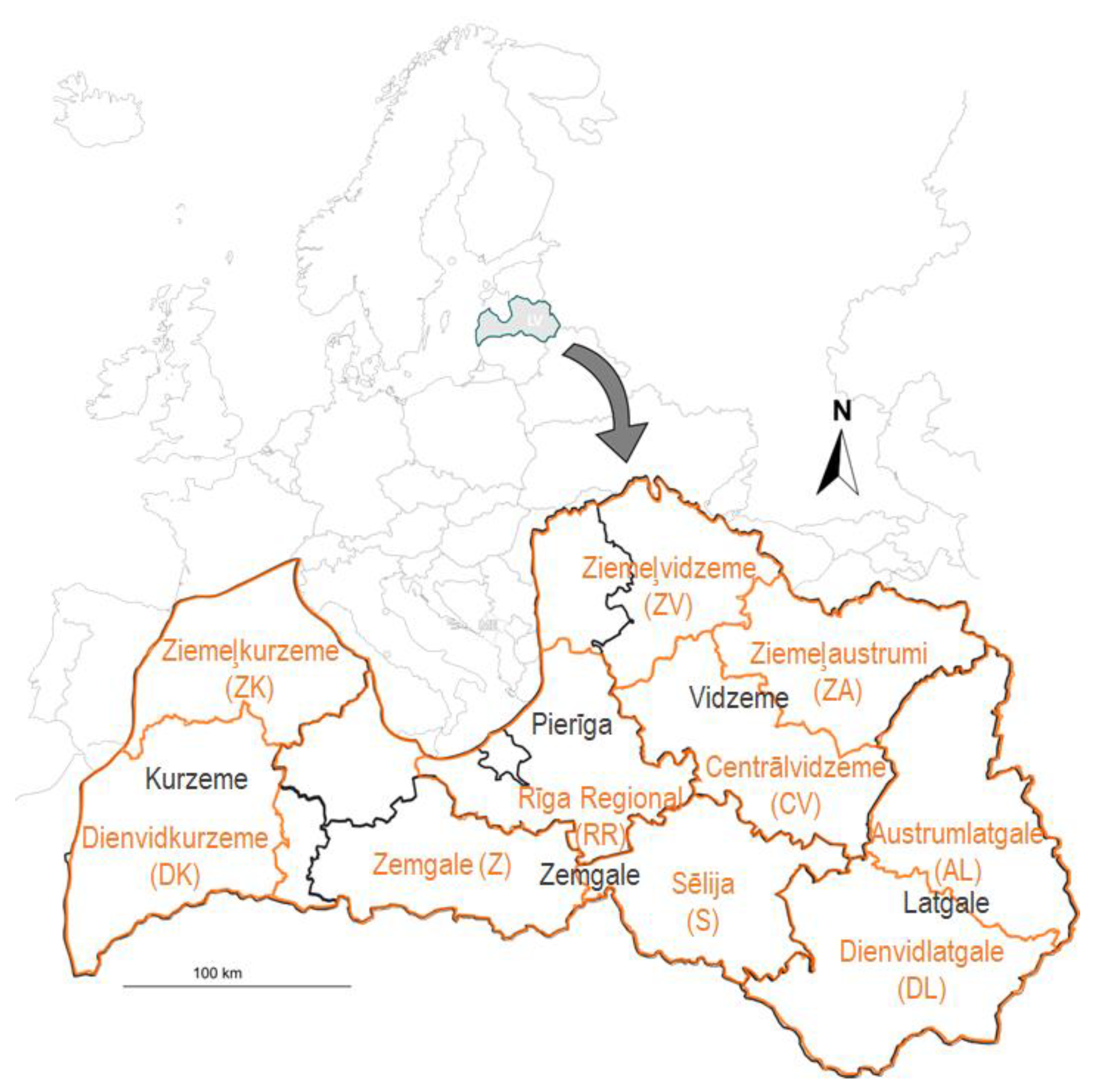
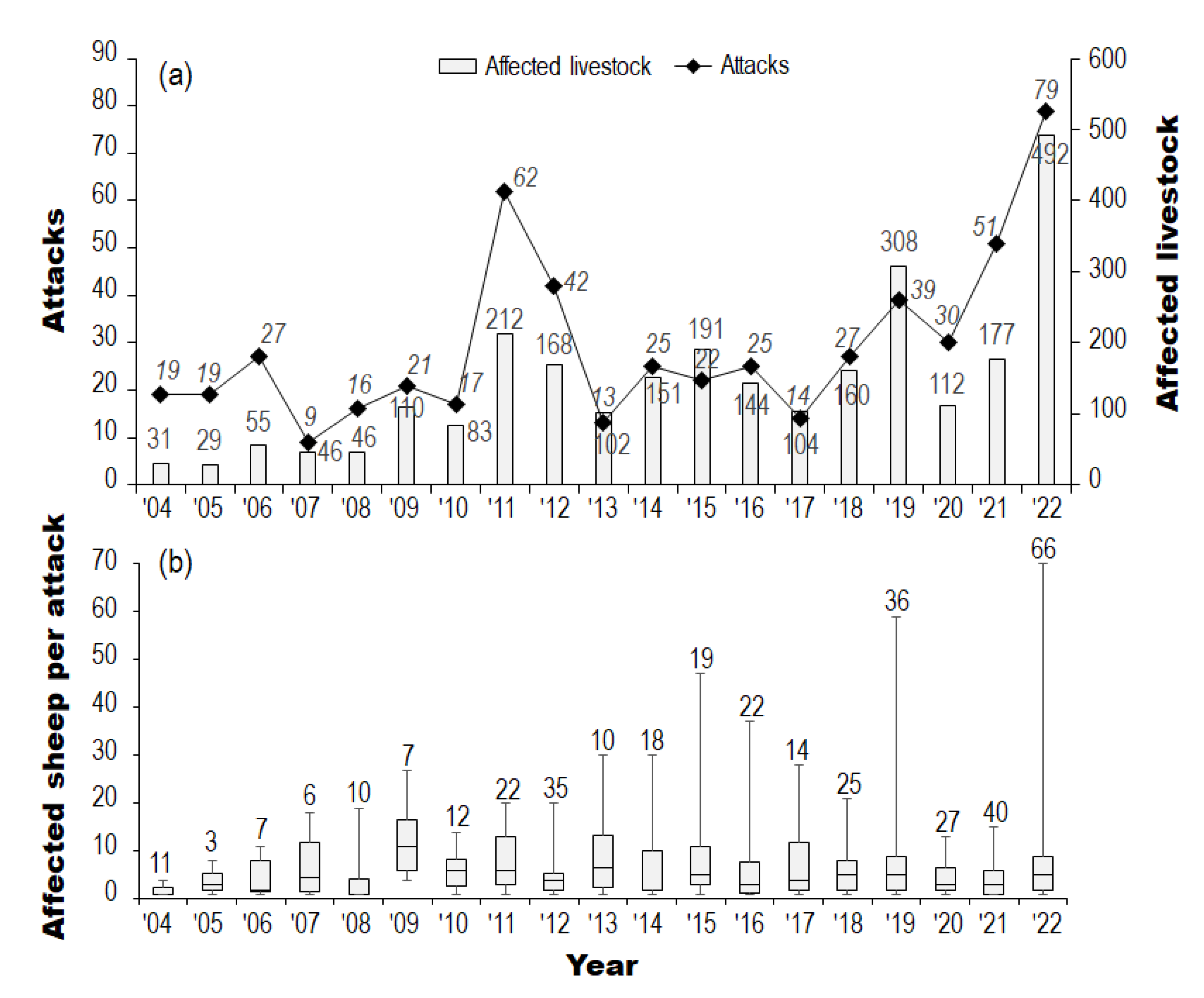
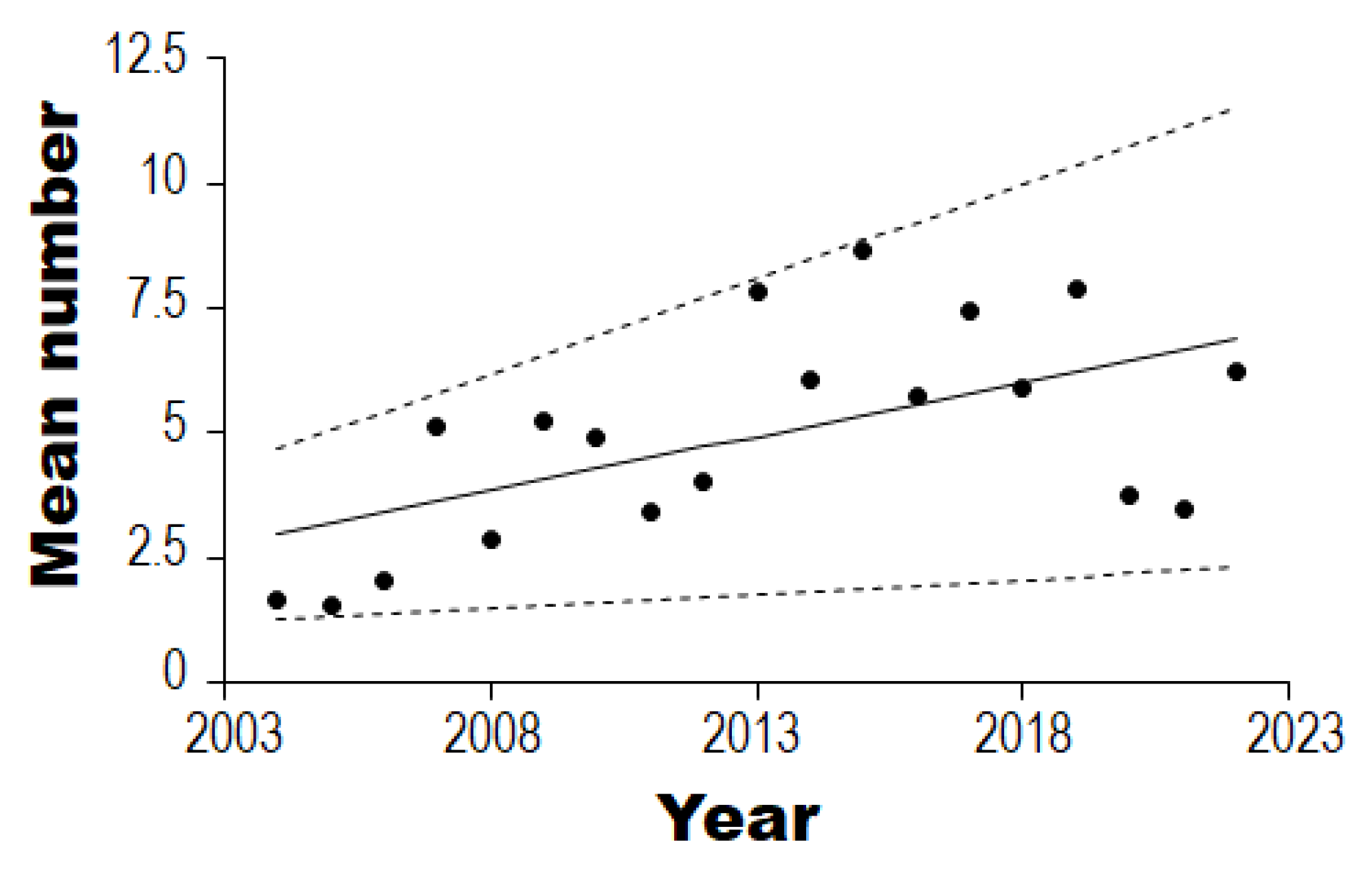
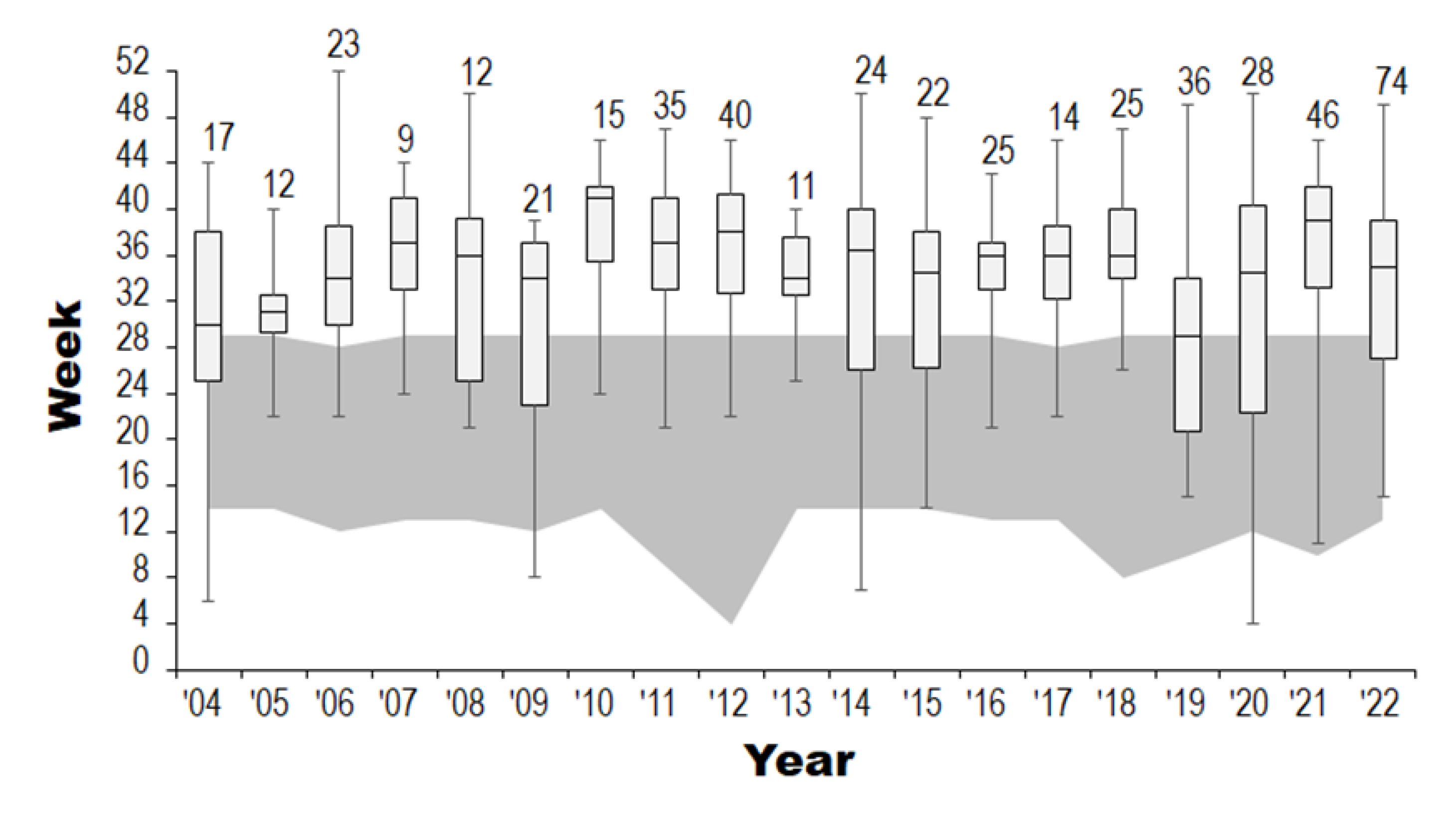
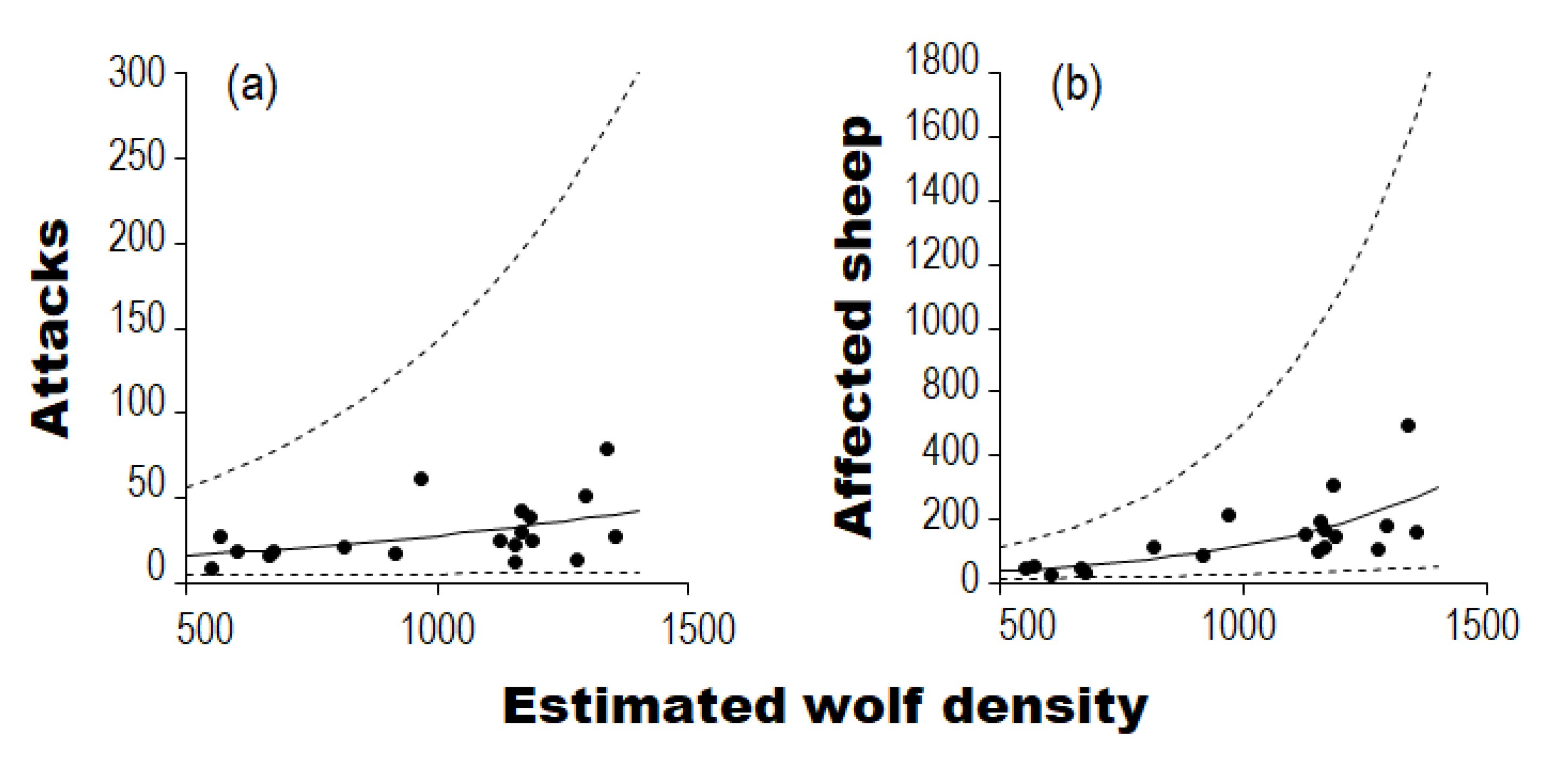
Disclaimer/Publisher’s Note: The statements, opinions and data contained in all publications are solely those of the individual author(s) and contributor(s) and not of MDPI and/or the editor(s). MDPI and/or the editor(s) disclaim responsibility for any injury to people or property resulting from any ideas, methods, instructions or products referred to in the content. |
© 2023 by the authors. Licensee MDPI, Basel, Switzerland. This article is an open access article distributed under the terms and conditions of the Creative Commons Attribution (CC BY) license (https://creativecommons.org/licenses/by/4.0/).
Share and Cite
Šuba, J.; Žunna, A.; Bagrade, G.; Done, G.; Ornicāns, A.; Pilāte, D.; Stepanova, A.; Ozoliņš, J. Does Wolf Management in Latvia Decrease Livestock Depredation? An Analysis of Available Data. Sustainability 2023, 15, 8509. https://doi.org/10.3390/su15118509
Šuba J, Žunna A, Bagrade G, Done G, Ornicāns A, Pilāte D, Stepanova A, Ozoliņš J. Does Wolf Management in Latvia Decrease Livestock Depredation? An Analysis of Available Data. Sustainability. 2023; 15(11):8509. https://doi.org/10.3390/su15118509
Chicago/Turabian StyleŠuba, Jurģis, Agrita Žunna, Guna Bagrade, Gundega Done, Aivars Ornicāns, Digna Pilāte, Alda Stepanova, and Jānis Ozoliņš. 2023. "Does Wolf Management in Latvia Decrease Livestock Depredation? An Analysis of Available Data" Sustainability 15, no. 11: 8509. https://doi.org/10.3390/su15118509
APA StyleŠuba, J., Žunna, A., Bagrade, G., Done, G., Ornicāns, A., Pilāte, D., Stepanova, A., & Ozoliņš, J. (2023). Does Wolf Management in Latvia Decrease Livestock Depredation? An Analysis of Available Data. Sustainability, 15(11), 8509. https://doi.org/10.3390/su15118509






